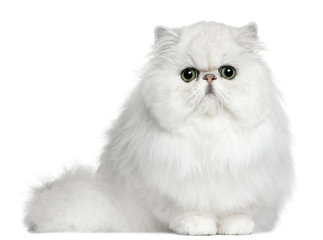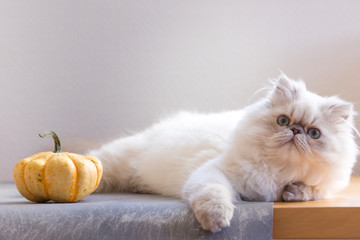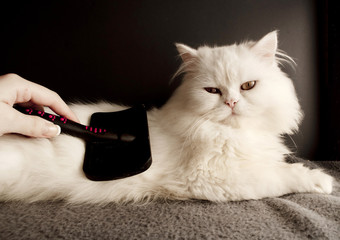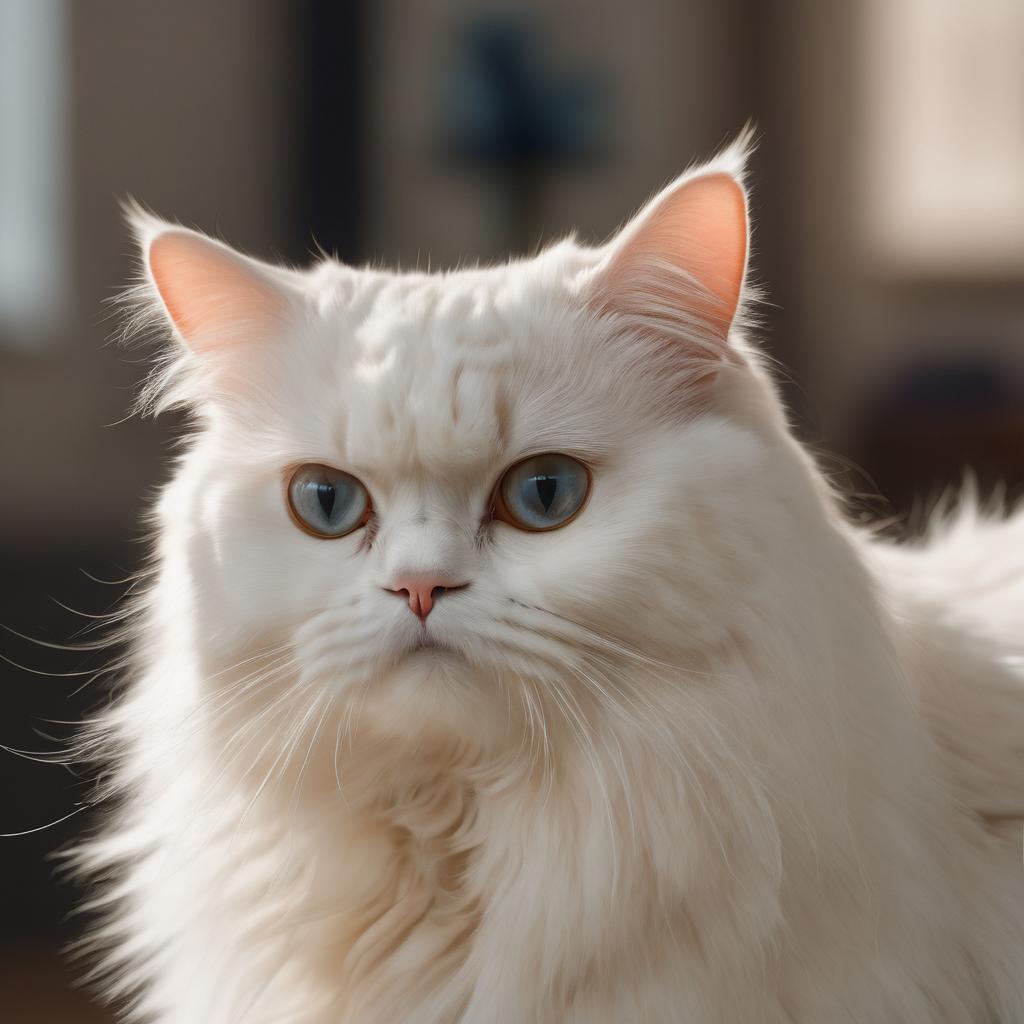In the US and around the world, Persian cats are quite popular. Throughout history, they have been in the spotlight and are among the oldest breeds of cats. Despite not being as active as other breeds, they are devoted to their owners and enjoy taking naps on their laps. The White Persian cat is one of the most recognizable breeds.
With their exquisite coat that turns heads everywhere, White Persians exhibit a sense of nobility. To maintain it healthy and glossy, their lengthy fur needs daily brushing. If you find the history and origins of White Persian cats fascinating, continue reading. We will also discuss living with a White Persian cat and provide information on the topic.
The History’s first Accounts of White Persian Cats
Persian cats have unclear exact origins, as do most breeds. It is commonly known that this

old breed came from someplace in Mesopotamia, which was formerly called Persia before it was renamed Iran in the present era.
Traveler Pietro Della Valle, an Italian, was drawn to the cat’s long hair and attractive appearance. In 1625, he brought it to Europe. The cat breed was brought to France by numerous more explorers, where it rapidly proliferated. The Persian cats that we know today were formerly referred to as French cats!
genetic origin
Modern Persian cats are more closely related to Western European cat breeds than to Near Eastern ones, according to recent genetic research. The researchers write, “Even though the early Persian cat may have in fact originated from Persia, the modern Persian cat has lost its phylogeographical signature.”
Physical Characteristics

Persian cats are medium-sized; they typically weigh seven to twelve pounds and stand between ten and fifteen inches tall. They feature large eyes, small, rounded ears, and a rounded head. They also usually have plump cheeks and a face that seems flat and pushed in. On the other hand, “traditional” or “doll-face” Persian cats resemble their progenitors in having more pointed features.
Persians Aren’t Big Jumpers
The fact that these cats are not known to jump is partially explained by their robust bodies and broad, sturdy legs. They much rather rest by hanging over the side of the couch or by having all four paws firmly planted on the ground.
The Coats of White Persians Are Exceptionally Thick
Their long, silky coat is one of their most distinctive features. They have a topcoat and an undercoat, which feels opulent to the touch but sheds a good deal.
Height
They are mosly 10–15 inches in height
Weight
Their weight is around 7–12 pounds.
Lifespan
10–15 years is their recorded life span
Temperament:
Mellow, quiet, easygoing, playful, and affectionate
They are suitable for families that can offer a quieter lifestyle
How Persian White Cats Became More Well-Known
Persians were already a well-liked breed in Europe by the 1700s. Because of Queen Victoria’s affection for them, they even attained royal or celebrity status. They arrived in America later in the 19th century, just when cat shows were starting to gain popularity.
Persian cat entrants were not uncommon, which added to the breed’s notoriety. Persian cats are still popular today. A few have starred in well-known films, such as Snowbell in Stuart Little (1999). They have also been the adorable sidekicks of well-known individuals like Kim Kardashian and Taylor Swift.
Official Acknowledgment of White Persian Cats
During the age of cat shows, Persian cats gained immense popularity as they appeared in exhibits and attracted large crowds. Both local and international cat societies took note of their accomplishment.
When the Cat Fanciers Association was founded in 1906, the Persian cat was among the first breeds to be registered. The White Persian is recognized by official breed standards as a valid color variation. It’s reasonable to suppose that the first white Persian was officially acknowledged in the 1900s.
The International Cat Association (TICA) and the Federation International Feline (FIFe) are two other organisations that acknowledge Persian cats
Potential health-related issues

Your Persian cat may be more susceptible to certain medical disorders, so being aware of what to look out for will speed up the diagnosis and treatment process.
Persian cats are brachycephalic, which means that their nasal passageways and skulls are shorter than average. Each Persian has brachycephaly to a different extent. Some people find it to be light and barely noticeable in their daily lives. Unfortunately, in more severe situations, it causes respiratory discomfort and difficulty breathing. This may also have an impact on the way these cats bite and chew, which could result in oral issues and trouble feeding.
Persians frequently experience “tear staining” or ocular discharge due to epiphora. Sometimes, because of their facial abnormalities, the tear film rolls down their faces instead of draining properly. Consequently, you will need to use a soft, warm, wet towel to gently wipe your cat’s face at least twice a day. Consult your veterinarian if tear staining appears to be extensive.
This breed is also prone to various ocular issues. They might experience conjunctivitis, also known as “pink eye,” corneal sequestrums, and anomalies of the eyelids.
Persian cats may be more susceptible to hypertrophic cardiomyopathy, which is characterised by a thickening of the heart’s muscle walls. This condition can impair heart function and cause heart illness in cats. Additionally, they can be more vulnerable to polycystic kidney disease, a hereditary disorder that can result in kidney cyst formation and subsequent renal illness.
Providing the best possible life for your Persian

Persian cats may have a number of health issues, but there are numerous ways to make sure they have a long and happy life. The most crucial thing is probably to take your Persian to the vet on a regular basis, but you can give it the food and stimulation it needs to thrive at home.
Persians don’t have a lot of energy, therefore you might have to be the one to push them to exercise. That’s not to say these cats aren’t playful at times—they most definitely are! When your Persian starts playing, consider it a great treat, and try to maintain the momentum for as long as you can.
Available interactive toys
Consider adding ball toys, laser lights, cat wands, and catnip to your Persian to offer their playtime a little extra excitement. Your Persian might like climbing a piece of cat furniture, even though this breed usually prefers to be at the same level as their humans (or even on the floor—so don’t forget a soft cat bed). They’ll love taking naps on one, for sure!
A proper diet
Persian cats have the tendency to gain weight due to their generally sedentary lifestyle. Being obese only increases a Persian’s vulnerability to the above mentioned medical disorders. Consider using an automatic pet feeder that dispenses nutritious portions multiple times a day if you’re worried about your Persian’s weight.
Requirements for grooming met
There is no avoiding it: Persian cats require a high level of grooming. To prevent matting and minimise shedding, their fine coat requires frequent brushing. It’s also crucial to give them an occasional bath, particularly because the lengthy fur around their buttocks can get, well, nasty. (A self-cleaning litter box comes in helpful in this situation!) Additionally, you will need to gently wipe their faces at least once a day because they are prone to getting stained by tears.
Veterinary checkups
A regular veterinarian checkup is crucial to the health maintenance of your Persian cat. Until your cat turns 10 years old (or older, if your cat has certain medical issues), make sure to take it to the vet once a year, and then at least twice a year after that. This breed is more susceptible to some illnesses, thus it’s critical to notice any changes in behavior or physical health.
Interesting Facts About White Persian Cats
A Persian Kitten Won the World’s First Cat Show
In 1871 Crystal Palace in London hosted the world’s first cat show. Popular cat breeds like Siamese cats, Persian cats, and Scottish Wild Cats were showcased on this platform. The performance drew a sizable audience and became popular right away. More than twenty thousand spectators watched as a Persian cat took home the title of “Best in Show.”
Not All Persians Have A Flat Face
Persian cats are brachycephalic cats, meaning their faces are frequently flat and smushed. In the 1950s, a single litter of kittens had this genetic alteration. Because of the mutation’s favourable result, more brachycephalic Persian cats were bred by breeders.Thankfully, some purebred Persians lack brachycephalic issues including runny eyes and breathing issues and are not flat-faced.
Persian cats are featured in the largest cat painting in the world
The record for the largest cat painting in the world was surpassed by Carl Kahler’s “My Wife’s Lovers,” one of the most famous paintings in history. It took up to three years to create and measures 6 feet by 8.5 feet. Fancy Persians are among the 42 cats that make an appearance in the masterwork. The picture brought $826,00 at a Sotheby’s auction in 2015
Welcoming a Persian cat
Knowing the specific requirements of the Persian cat breed is crucial if you’re considering adopting one. Persian cats can live long, happy lives full of the love and laughter of your home, yet certain medical issues can shorten their longevity. A Persian cat will welcome you with wide arms and show you a unique form of affection that will stay with you forever.
Final Remarks
Among the oldest cats in the world are Persian cats. They make wonderful companions and are adored for their stunning appearance and kind disposition. This also applies to White Persians. It’s difficult to argue against their fluffy white coats, even though they are merely a color variant of the breed. This adds to their overall cuteness.
Make sure a White Persian is the ideal fit for your lifestyle before you adopt them. The breed is prone to a number of congenital medical conditions, much like many purebreds, thus getting pet insurance is essential. Purchasing a cat from a reputable breeder increases your chances of having a happy, healthy cat.







